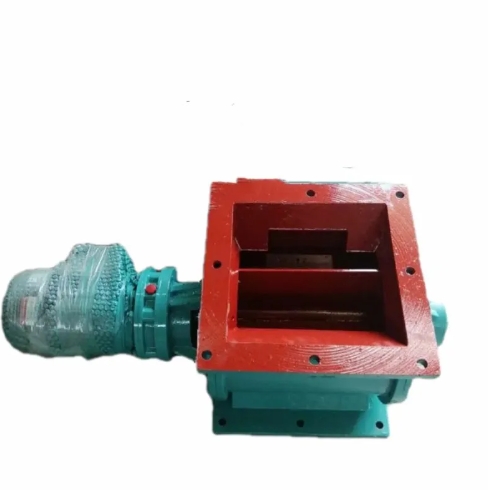Enhancing Industrial Dust Control with Dust Collector Dust Discharge Valves
2024-08-27
In industrial settings where dust and particulate matter are a constant concern, maintaining effective dust control is critical. Dust collectors are the backbone of such systems, capturing airborne particles before they can harm workers or equipment. However, a dust collection system is only as effective as its components, and the dust discharge valve is one of the most vital elements. This blog will delve into how dust collector dust discharge valves enhance industrial dust control, the benefits they provide, and key considerations for optimizing their performance.
The Role of Dust Collector Dust Discharge Valves in Industrial Dust Control
Dust collector dust discharge valves are integral to the function of dust collection systems in various industries, from manufacturing to mining. These valves are responsible for managing the release of collected dust from the system, ensuring that it does not re-enter the workspace or environment.
- Continuous Operation: In many industrial applications, dust collection systems must operate continuously to handle large volumes of dust. Dust discharge valves play a crucial role in allowing these systems to operate efficiently by regularly discharging collected dust without interrupting the process.
- Maintaining System Efficiency: The efficiency of a dust collection system depends on its ability to continuously remove dust from the air. By ensuring that collected dust is quickly and efficiently discharged, the valve helps maintain the overall efficiency of the system.
- Preventing Environmental Contamination: Proper dust discharge is essential to prevent dust from escaping into the environment, which could lead to regulatory fines, environmental damage, or health hazards. Dust discharge valves provide the necessary control to ensure that all collected dust is handled appropriately.
Key Benefits of Using Dust Discharge Valves
Implementing the right dust discharge valve in your dust collection system offers several benefits that enhance both operational efficiency and workplace safety.
- Improved Air Quality: By effectively removing dust from the system, discharge valves help improve air quality within the workplace. This is especially important in industries where workers are exposed to fine dust particles that can cause respiratory issues.
- Enhanced Safety: Dust accumulation can lead to hazardous conditions, such as fire or explosion risks in environments where combustible dust is present. Dust discharge valves help mitigate these risks by ensuring that dust does not build up within the system.
- Reduced Maintenance Costs: Efficient dust discharge valves can reduce the frequency of maintenance required for the dust collection system. By preventing clogs and ensuring smooth operation, these valves help extend the life of the system's components.
- Compliance with Regulations: Many industries are subject to strict regulations regarding dust emissions. Properly functioning dust discharge valves help ensure that your dust collection system complies with these regulations, avoiding potential fines and ensuring a safer working environment.
Selecting the Right Dust Discharge Valve for Your System
Choosing the right dust discharge valve involves considering several factors, including the type of dust, the operating conditions, and the specific requirements of your dust collection system.
- Material Compatibility: The valve material should be compatible with the type of dust being collected. For example, abrasive dust may require valves made from hardened steel or other durable materials.
- Operating Temperature and Pressure: The valve must be able to withstand the operating temperature and pressure of the dust collection system. High-temperature environments may require valves with special seals or coatings.
- Valve Size and Capacity: The size of the valve should match the capacity of the dust collection system. A valve that is too small may lead to clogs, while a valve that is too large may not provide the necessary control.
- Automation and Control Options: Depending on the system's needs, you may require a valve that can be automated for timed or sensor-based operation. This can enhance efficiency by ensuring that dust is discharged at optimal intervals.
Optimizing the Performance of Dust Discharge Valves
To get the most out of your dust discharge valve, it's important to follow best practices for installation, operation, and maintenance.
- Proper Installation: Ensure that the valve is installed correctly according to the manufacturer's instructions. This includes ensuring a proper seal and alignment with the dust collection system's hopper or chute.
- Regular Maintenance: Perform regular inspections and maintenance on the valve to check for signs of wear, clogs, or leaks. Timely maintenance can prevent small issues from becoming major problems.
- Monitoring Performance: Use sensors or other monitoring tools to track the performance of the dust discharge valve. This can help identify any inefficiencies or issues that may need to be addressed.
Conclusion
The dust collector dust discharge valve is a critical component that significantly enhances industrial dust control. By ensuring the efficient and controlled removal of collected dust, these valves contribute to better air quality, improved safety, and overall system efficiency. Selecting the right valve for your system and maintaining it properly are key to maximizing these benefits. Whether you’re upgrading an existing dust collection system or installing a new one, paying attention to the dust discharge valve can make all the difference in achieving optimal dust control.



